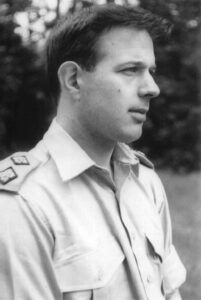Pendine sits on the western edge of Carmarthen county, overlooking the famous Pendine Sands. The village of Pendine was made famous during the halcyon days of motor racing, when several world land speed records were set on its famous five mile beach. The area is surrounded by several ancient hill forts, but today is best known as a holiday resort. The village did not originally have a War Memorial to commemorate its fallen and on Remembrance Sunday every year, a list of eighteen men is read out during the service at St. Margaret’s Church, Pendine. Recently this situation has been rectified and a new War Memorial has been erected inside the Church. Some of these men are commemorated on the Marros and Red Roses War Memorials, and some on the Laugharne Memorial. There are several men who were born locally that are not commemorated here, but all are included below.
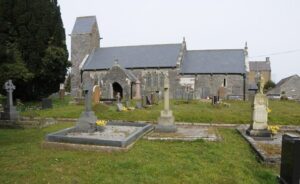
The Boer War, 1899-1902
Herbert Wodehouse Taylor, Captain, Royal Horse Artillery. Herbert was born in South Africa on 18 June 1868, the son of General Markham Le Fer Taylor and Frances Elizabeth Taylor (nee Doyne). He was educated at Clifton and Wellington before being commissioned into the Royal Artillery in February 1887. He was serving in India when he met Constance Jane Frances Jones, the daughter of Reverend Morgan Jones, of Llandygwydd and the couple married at Mhow on 17 January 1894. By October 1897 Herbert had been promoted to Captain and embarked for South Africa in January 1900, joining M Battery, Royal Horse Artillery. Herbert was killed in action during an action against the Boers at Geluk, between Machadodorp and Heidelberg, on 13 October 1900. He is buried in Machadodorp Main Cemetery, Mpumalanga. Herbert is commemorated at Clifton College and also on a fine leaded window in St Margaret’s Church, Eglwyscymmin.
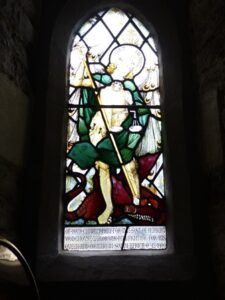
The Great War, 1914-1918
Thomas George Cole, Private, 263014, Cheshire Regiment. Thomas was born on 8 October 1892, the son of Benjamin and Martha Cole, of The Village, Lawrenny. Thomas married a Pendine girl, Mary Elizabeth Cole, and they lived at Pulth Green, Pendine. Thomas enlisted into the local Regiment, along with many of his new friends from Pendine and Laugharne, the Pembroke Yeomanry. He must have enlisted just as the Pembroke Yeomanry were merged with the Glamorgan yeomanry, becoming the 24th Battalion, Welsh Regiment, where his service number changed from his yeomanry number of 5001, to 56859. Sometime during the latter stages of the war, Thomas was probably wounded, as he was then posted to the 11th Battalion, Cheshire Regiment, with a new service number, 263014. The 11th Battalion, Cheshire regiment was a service Battalion that had been formed at Chester in September 1914 as part of K3. It was attached to 75 Brigade, 25th Division until 17 June 1918, when it was reduced to cadre strength and transferred to the 39th Division. After heavy losses during the German offensives of March 1918, the Division became a training Division, that was tasked with training American Units to fight on the Western front. Unfortunately there are no service records existing to trace where Thomas fought, but he died of disease in Germany on 5 December 1918, aged 26, probably of influenza. He was buried in Berlin South Western Cemetery, in grave ZVII.D.7.
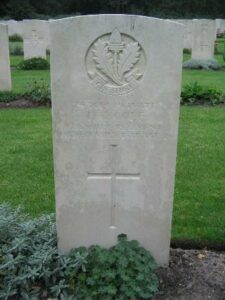
Henry Harcourt Howells, Private, 32543, Royal Warwickshire Regiment. Henry was born at Marros in 1892, the son of Peter and Rachel Howells, of Talvan, Marros. Prior to the war the family were residing at Rhymney, and Henry enlisted at Cardiff into the Welsh Horse Yeomanry. After the Welsh Horse embarked for Gallipoli, Henry was transferred to the Middlesex Regiment, then to the 17th Lancers, before landing in France, where he joined the 14th Battalion, Royal Warwickshire Regiment. The battalion was attached to 13 Brigade, 5th Division, and Henry probably joined them on the Somme. On 1 July 1916 the Battle of the Somme opened, and the Division fought at High Wood, Guillemont, Flers-Courcelette, Morval and Le Transloy. On 5 October, after suffering heavy casualties, the Division moved to Festubert, where they remained until March 1917, until taking part in the Battle of Arras. On 7 September 1917 the Division was pulled out of the line, and moved north to Ypres, and on 26 September 1917 fought at the Battle of Polygon Wood, and in the ensuing Battle of Broodseinde. Henry was killed in action at Broodseinde on 5 October 1917. He was 25 years old, and is commemorated on the Tyne Cot Memorial, Belgium. Henry is not commemorated at Pendine, but at Jeffreyston.
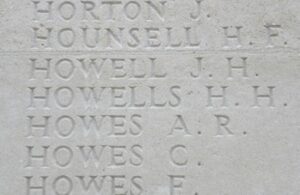
William John Howells, Captain, Welsh Regiment. William was born in White Lion Farm, Eglwys Cummin, in 1888, the son of Daniel Howells and Mary Ann Howells (nee John). He was raised by his Grandparents Ben and Mary John, at Brook, before being educated at Tremoilet School and Whitland Grammar Schools, before gaining a BA with Honours at Aberystwyth University. He then moved on to work in Lampeter University before the war broke out. William enlisted into the Welsh Regiment at the outbreak of hostilities, and was commissioned into the 8th Battalion, the Welsh regiment as a Lieutenant. The 8th Battalion formed at Cardiff during August 1914 as part of K.1. They were then attached to 40th Brigade, 13th Western Division. The 40th Brigade assembled at Salisbury Plain along with 40 Division, and then moved to Chiseldon and Cirencester in September 1914. Toward the end of February 1915, the entire Division concentrated at Blackdown in Hampshire. On 7 June 1915 orders were received for the Division to move to the Mediterranean, then by 4 July from Alexandria to Mudros-preparing for the landing on Gallipoli. On 4 July 1915 the Division landed on Cape Helles and relieved the 29th Division. From there, the Division took part in several actions, most notably The Battle of Sari Bair between 6-10 August 1915 and the Battle of Russell’s Top on 7 August 1915. The Battalion War Diary for the period from 8 August 1915 shows that they had moved up to positions around Chunuk Bair, in support of the Gloucester’s and the Wellington Battalion. The fighting was ferocious and the diary shows that on that one day, the 8th Battalion suffered 4 Officers and 4 Other ranks killed, 9 Officers and 154 Other Ranks wounded, and 4 Officers and 266 Other Ranks Missing in Action. Among the wounded officers was William. He was evacuated from Gallipoli, but died of his wounds on 10 August 1915, aged 23, aboard the Hospital Ship HMHS Valdivia. William was buried at sea, so he is commemorated on the Helles memorial, Turkey, on Panel 140-144. William is not commemorated on the Pendine Roll of Honour, but is on the Whitland War Memorial.
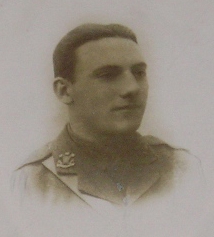
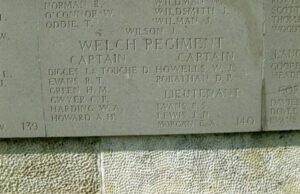
William Arthur Killa, Private, 4301, Welsh Regiment. William was born in Pendine on 30 October 1894, the son of John and Esther Killa. The family was from Laugharne, but had resided at Pendine for several years, before moving to Alltycnap Road, Carmarthen. William’s Grandparents stayed in Laugharne. William enlisted into the 1/4th Battalion of the Welsh Regiment in August 1914. The 1/4th was a territorial Battalion, and it formed part of South Wales Brigade. On 17 April 1915 it was attached to 159th Brigade, 53rd Division and on 8 October 1915 amalgamated with 1/5th Battalion forming 4/5th Welsh Composite Battalion. In July 1915, the 53rd Welsh Division was shipped to Egypt and there they trained for the Gallipoli Campaign. On 9 August 1915, the Division landed at Suvla on Gallipoli. The day after landing on the hostile shores of Gallipoli, William was killed in Action. He was just 20 years old and had seen just one day of fighting. He is remembered on the Helles Memorial in Gallipoli. William is not commemorated on the Pendine Roll of Honour, but at Llangynog.
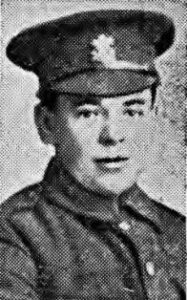
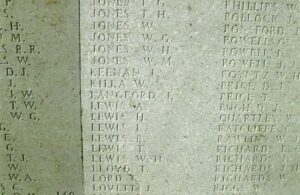
Henry John Lewis, Lance Corporal, 56870, Welsh Regiment. Henry was born on 12 August 1895, the fourth of eleven children of Thomas and Anne Lewis, of Underhill, Marros. Henry enlisted into the Pembroke Yeomanry on 29 November 1915, serving as a Private with the service Number 5038, before transferring into the 13th Battalion, the Welsh Regiment in September 1916. The 13th Battalion was attached to 114 Brigade, 38th Welsh Division, and had just been mauled at Mametz Wood during the Somme Offensives. The division was then sent to the Ypres salient, where it held the line at the Canal Bank at Boesinghe for almost twelve months, before taking part in the Battle of Pilckem Ridge, where they captured their objectives under terrible conditions, against the Prussian Guard Division. The 38th Welsh Division then moved back to the Somme sector of the allied lines. There they took part in the defence against the German advances of 1918, before the tide turned and the Allied armies began their great advances toward the end of the war. From 21 August 1918, the division fought their way from Albert to Bapaume, driving the Germans before them, and through to the previously untouchable Hindenburg Line. On 28 August 1918, whilst the 13th Battalion, Welsh Regiment were fighting in the area around Delville Wood, Corporal John Lewis was killed in Action. He was just 23 years old, and was buried in Bulls Road Cemetery, Flers, in grave III.B.2. Henry is commemorated on the Marros War Memorial.
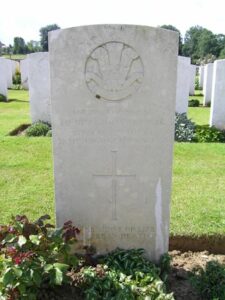
Peter McElroy, Private, 39794, Welsh Regiment. Peter was born at Derry Crow, Newry, County Down, Ireland on 8 September 1879, the son of Peter and Ellen McElroy. He worked as a Farm Labourer in Marros prior to the outbreak of the Great War. He enlisted on 11 November 1915 at Carmarthen, and served with the 9th Battalion, Welsh Regiment. Peter was relatively old for the rigours of military service though, and was discharged on 8 March 1917 as no longer fit for war service, due to suffering from TB. His address at demob was given as 32, Bridge Street, Carmarthen and one of the Medical Boards was at Pembroke Dock. Peter died of Tuberculosis on 12 May 1918, aged 38. He is buried at Tregaron (St. Caron) Churchyard Extension, Ceredigion. Peter is commemorated on the Marros War Memorial.
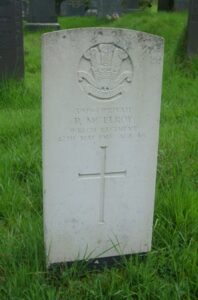
Richard Smith, Private, 35086, Welsh Regiment. Richard was the son of Dalhousie and Lucy Smith, of Eastbourne, Sussex and moved to Pendine before the war broke out, working for Mrs. Ebsworth of Sea View. Richard enlisted into the army at Cardiff with the two sons of Mrs Ebsworth, joining the 9th Battalion of the Welsh Regiment. The 9th Welsh formed in Cardiff in September 1914, forming part of 58 Brigade, 19th Western Division, as part of the Second New Army, which served in France for the duration of the War. The first trial for the division was during the Battle of Loos, between 25 September and 8 October 1915. From here the division moved to the Somme, and began preparing for their part in the Great Battle of the Somme. Richard would have fought through the Battle for Albert, and the capture of Montauban, Mametz, Fricourt, Contalmaison and La Boisselle-where the huge Lochnagar Crater had been blown on 1 July. The fighting raged on for Richard and the 19th Division, taking them to the Hellish battle for High Wood, and the attack and capture of Pozieres village alongside the Australian Imperial Force. When the fighting for Pozieres and Mouquet Farm was over, the next stage for the 19th Division was the Battle for the Ancre Heights, which took place in the first half of October. The division captured the strongly held German positions of the Schwaben Redoubt, Stuff Redoubt and Regina Trench, before moving on to capture Beaumont Hamel during the Battle of the Ancre, from 13-18 November 1916. The war diary for the 9th Welsh shows that their position from 13 November 1916 was at Stuff Redoubt, from where the battalion launched an attack on Desire Trench. It was during this period of fighting that Richard was killed in action on 15 November 1916. He was 21 years old, and was buried at Regina Trench Cemetery, near Grandcourt on the Somme in grave VII.M.17. Just two days later the Battalion withdrew to billets in ‘Wellington Huts W12D’.
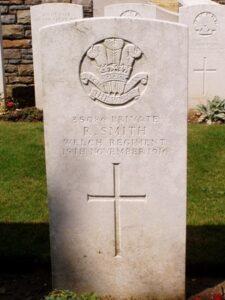
William Arthur Williams, Corporal, 6356, Cavalry. William was the grandson of Martha Richards, of the New Inn, near Marros. He appears to have been the illegitimate son of Martha’s daughter, Leah Jane Williams. William worked as a farm servant for William Ebsworth at Marros Farm before he moved to Ystalyfera and married Gladys Baber, of 22, Canal Street, Ystalyfera, in 1913. William enlisted into the 17th Lancers (Duke of Cambridge’s Own) prior to the war and landed in France on 19 October 1914, joining the 2nd Life Guards, which was under command of the 7th Cavalry Brigade, 3rd Cavalry Division. William joined up with the division in time to take part in the First Battle of Ypres, where the vastly outnumbered BEF stopped the German drive towards the Channel ports by holding the city of Ypres. The division wintered in the Ypres Salient and became caught up in another German offensive just months later, the Second Battle of Ypres, which was launched on 22 April 1915. The opening of the battle was heralded by the first use of poison gas when the Germans launched a gas attack against the French Colonial troops at Gravenstafel. Only brave fighting by the Canadians stopped a break-through, but the battle continued to rage. After weeks of continual fighting, by the second week of May William was in the front line with the 2nd Life Guards near Frezenberg Ridge. At 4 am on 13 May 1915 a heavy artillery barrage opened up on the British line around Ypres, and was followed by a massed attack by the German infantry. During a terrible day of fighting, the 3rd Cavalry Division lost over 90 officers and 1,500 men. William, who was 28 years old, was among those killed on 13 May. He has no known grave and is commemorated on panel 5 of the Ypres (Menin Gate) Memorial, Belgium. His widow Gladys later remarried and lived at 4, Emma’s Buildings, Hill Street, Hull. William does not appear to be commemorated locally, but is named on the Ystalyfera War Memorial.
World War Two, 1939-1945
James Henry Coppin, Trooper, 3969021, 22nd Dragoons. James was born around 1916, the son of William and Jane Coppin, of Bermondsey, London. James had been training with the 22nd Dragoons at Pendine Establishment when he met and married Doris Irene Moore in June 1944. James was a trooper in the 22nd Dragoons, which was part of the Royal Armoured Corps-the forerunner to the Royal Tank Regiment. The 22nd Dragoons played a vitally important yet often overlooked part in the invasion of occupied France, which began on D-Day, 6 June 1944. The 22nd Dragoons were formed on 1 December 1940 at Blundellsands from a nucleus of 4/7th Royal Dragoon Guards and 5th Royal Inniskilling Dragoon Guards. On 11 January 1941 the 22nd Dragoons transferred to 30th Armoured Brigade, which joined 79th Armoured Division on 18 October 1943, based at Stow on the Wold, where it became a Flail Regiment, equipped with the Sherman Tank. This was one of several variations of this tank nicknamed ‘The Funnies’ due to their strange looking attachments. The flail tank was used to clear paths through the minefields of the Normandy Beachheads on D-Day and through to Germany, and the crew faced immense dangers in this task, due to having to be the spearhead of any attack over terrain where minefields were present. On D-Day, the 22nd Dragoons landed on Word and Juno Beaches in Normandy. They were to spearhead the drive to push the Germans from the beaches, led the advance on Caen. The Battle for Normandy was to last for nearly three months. The battle to extend the bridgehead was won within ten days and, after a hard-fought struggle, the port of Cherbourg was captured at the end of June, but it was then that all their problems started. July was the blackest month for the Allies. The British and Canadians were kept at bay north of Caen by German armoured divisions. Only on 19 July 1944 was the city entirely liberated. During this time, the Americans made little headway in the Cotentin Peninsula, bogged down in the war of the hedgerows and managing to capture Saint-Lô with only the greatest difficulty on 18 July. James was killed during Operation Goodwood, on 19 July 1944, when his Sherman was hit by a rocket fired from a German Panzerfaust and exploded. His body was not recovered, and so James is remembered on the Bayeux War Memorial France, on Panel 8, Column 1.
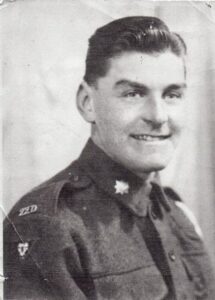
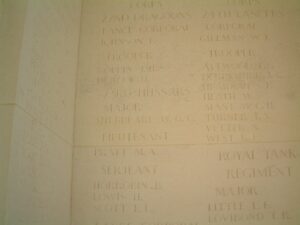
Gwilym Davies, The Queens Own Regiment. Gwilym cannot presently be identified.
Lyndon Morgan Evans, Leading Aircraftman, 1303024, Royal Air Force Volunteer Reserve. Lyndon was the son of John and Alice Evans of Pendine. He served as Leading Aircraftman, Number 1303024, with the Royal Air Force Volunteer Reserve. He married Janet Tyson, of Pontyberem, while based at Whitehaven in 1942. Very little is known of Lyndon, but he died at home on 15 October 1944 aged 24, and is buried at Whitehaven Cemetery. Lyndon is also commemorated on the Pontyberem War Memorial.
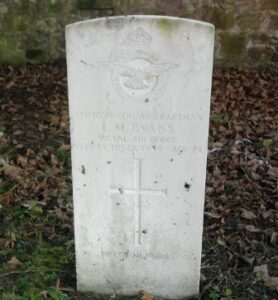
John Fyffe, Intelligence Corps. John canot presently be identified.
Reginald Allenby Douglas Griffiths, Lance Corporal, 6402909, Royal Sussex Regiment. Reginald was the son of Dan and Margaret Griffiths, of Red Roses. He served in the 4th Battalion, Royal Sussex Regiment. The Battalion was part of the B.E.F. in France at the outbreak of war, and were evacuated from Dunkirk after suffering heavy losses. In May 1942 the Battalion sailed to North Africa, as part of 44th Division, and landed at Suez in July, 1942, joining the 8th Army. They fought the Afrika Corps at Alan El Haifa, then joined the 10th Armoured Division. The Battle of El Alamein started on 23 October 1942, and four days later the 4th Sussex were ordered to capture Woodcock. They successfully advanced two miles into the German lines, suffering heavy casualties, one of which was Reginald, who was killed in action on 27 October 1942, aged 24. He is buried at El Alamein War Cemetery. Reginald is commemorated on the Red Roses War Memorial.
William Valentine Isaac, Private, 42264, East Yorkshire Regiment. William was the son of Thomas Lewis Isaac and Charlotte Isaac (nee John), of Mafeking Villa, Pendine. He served during the Great War with the 11th Battalion, East Yorkshire Regiment. The battalion was formed in Hull on 2 September 1914 by Lord Nunburnholme and the East Riding TF Association, and was commonly known as the Hull Tradesmen’s Battalion. In June 1915 it became attached to 92 Brigade, 31st Division. During December 1915 the Division moved to Egypt, and took part in the defence of Suez Canal. In March, 1916 they moved to France and proceeded to the Western Front, where they saw their major action at the Battle of Albert in July 1916. The Division took part in the assault on Serre, and suffered very high casualties. It was withdrawn for several months as a result. They moved back into the line in November, 1916 and took part in the Battle of the Ancre, and then wintered on the Ancre, until moving to Arras the following year. Here they fought at the Third Battle of the Scarpe, and helped in the capture of Oppy Wood. At the beginning of 1918 the Division were in the St. Quentin sector. It was here that they were among the Divisions hit by the German Spring Offensive of the 21st March, 1918 at the Battle of St Quentin. The Division withdrew west, fighting at the First Battle of Bapaume, and then at the First Battle of Arras. After suffering terrible casualties the Division were moved to Flanders to rest, but in April the Germans launched an offensive in Flanders, and the Division were caught up in the fighting there, at the Battle of Estaires, and then at the Battle of Hazebrouck where they played a part in the Defence of Nieppe Forest. In August, 1918 the war turned in favour of the Allies, and the Division took part in the Advance in Flanders. They then fought at the Battle of Ypres, and the subsequent Action of Tieghem. Little else is presently known of William, but he was still serving towards the end of 1918, and was awarded the British War and Victory Medals for his wartime services. He died on 16 October 1944, but is not recorded by the CWGC.
David Stanley Moore, Trooper, 3913087, 3rd/4th County of London Yeomanry (Sharpshooters). Stan was born in 1916, and was called up for military service at the outbreak of the Second World War. Following his basic training, was posted to the Tank Training centre at Bovingdon, Dorset. Stan trained as a Tank Driver, and upon finishing training, was posted to the Royal Armoured Corps, in North Africa. After four months with the RAC Stanley was transferred to the 3rd County of London Yeomanry-the Sharpshooters. They were sent to Sicily on 10 July, 1943. After six months fighting in Sicily and Italy, the Sharpshooters were sent back to Britain, to prepare for D-Day. On 27 January 1944 they sailed from Taranto aboard M.V. Tegelberg, and arrived at the Clyde 12 days later. Stan was based at Worthing from February 1944 to May 1944, and sailed from Gosport to Normandy on the day after D-Day. In a letter home from Normandy dated 19 July 1944, Stan wrote, ‘It was a sight that I shall never forget and we only saw half of them. It made us feel a lot better.’ He was referring to the large swarms of Allied aircraft that filled the skies. There were two huge air raids over Caen in July 1944. The first, on 7 July, was on Caen itself, the second on 17 July, to the east and south-east of the city. During the latter, Stan’s regiment were about eight miles west of Caen and had a good view of the raid. After fighting hard to push the Germans back from Caen, the Sharpshooters took place in the Battle of the Falais Pocket. Their part was to take the village of Roufigny, which they captured on 18 August. Stan was killed in action during the Battle for the village on 18 August 1944, aged 28, and was buried on the battlefield. Afterwards, his body was re-interred at Banneville La Campagne War Cemetery, 10 miles East of Caen, in grave IV.B.22.
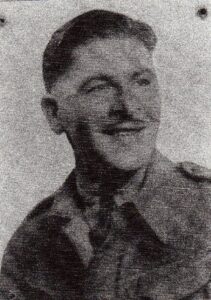
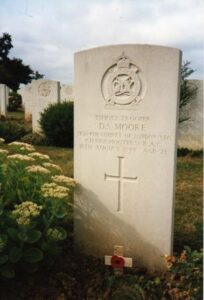
Stanley Lewis Morgan, Leading Stoker, D/K65937, Royal Navy. Stanley was the son of William and Elizabeth Morgan, of Union Cottage, Narberth. He married Dorothy Sarah Thomas, of Marros in 1929. Stanley was a pre-war regular in the Royal Navy, serving aboard the York class cruiser HMS Exeter. She was attached to the South American Division during WW2, taking part in the Battle of the River Plate. During the battle, she lost 61 crew killed, and a further 23 wounded. After withdrawing to Port Stanley for temporary repairs, Exeter made for Devonport, where she was refitted. She returned to service in 1941, taking part in the Bismark episode before being posted to the ABDACOM Naval force in the Pacific, due to Japans entry into the war. The brief of ABDACOM was to protect the Dutch East Indies (now Indonesia), and it was here on 27 February 1942 that the Exeter took part in the Battle of the Java Sea, where she suffered a direct hit in the boiler room. Whilst attempting to withdraw to Surabaya, the Exeter was attacked again, finally being sunk by a torpedo on 1 March 1942. Stanley died on 27 February 1942, aged 35, and is buried at Jakarta War Cemetery, in Grave 5.K.5. It is unknown whether he died of wounds suffered during the initial battle, or was already in Jakarta, suffering from illness.
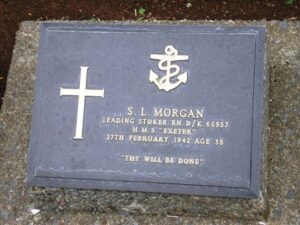
James Edward O’Brien, Sapper, 4208432, Royal Engineers. James, or Jimmy as he was known, was born in 1922, the son of Patrick O’Brien and Fanny O’Brien (nee Giles), of Delphin, Cyffig. He served in the 1024 Docks Operating Company, Royal Engineers. The men of the Company consisted of the various trades required to operate a dockyard, crane drivers, forklift drivers, engine drivers and so on. Jimmy was possibly an engine driver with the GWR, which led to his being called up into the Royal Engineers, and he served with them in North Africa, but was posted as missing, believed killed, in Tunisia on 4 August 1943. No trace of the 20-year-old was ever found, so he is commemorated on the Medjez-el-Bab Memorial, 60 km west of Tunis. Jimmy is commemorated on both the Red Roses and the Whitland War Memorials.
Leslie George Islwyn Owen, Sergeant (Observor), 1288474, Royal Air Force Volunteer Reserve. Leslie was born on 26 May 1917, the son of Hugh Vaughan Owen and Rowena Lilian Owen (nee Lawrence), of Hazel Grove, Red Roses. After leaving school, Leslie became a Chemist’s Assistant and lodged at 14, Spring Gardens, Narberth. Leslie enlisted into the Royal Air Force Volunteer Reserve and after completing his training as an Observer was posted to 148 Squadron, Royal Air Force. The squadron had formed at Scampton as a long range medium bomber unit in 1937. By March 1939 the Squadron were armed with Vickers Wellingtons, and moved to R.A.F. Harwell, then moved to Malta in December 1940 from where it flew valuable bombing raids over North Africa. The squadron then moved again, to RAF Kabrit, in Egypt, to support the campaign in the Western Desert. On 8 July 1942 Leslie took off from Kabrit aboard a Vickers Wellington Ic, Serial T2985, under the command of Flying Officer Frank Tribe, as part of a bomber force despatched to strike targets in Tobruk Harbour. The Wellington was damaged during the raid and crashed some ten miles Southwest of Shallufa whilst attempting to return to Kabrit, killing all six of her crew. The graves of the crew were located in the desert in 1950 and all six men were buried in a collective grave in Fayid War Cemetery, Egypt. Leslie was 25 years old. Leslie is also commemorated on the Red Roses War Memorial.
Austin Thomas Phillips, Leading Stoker, D/KX 91896, Royal Navy. Austin was born on 29 January 1918, and was the son of Richard Lewis Phillips and Mary Winifred Phillips of Brook Cottage, near Laugharne. Austin was married to Margaret Winifred Phillips and they had a daughter Rose Mary Phillips. Austin was a pupil of Brook School, before he went to Whitland Grammar School at 11. After leaving school at 17 years old, Austin Phillips went to work at Great House Farm, Laugharne, before enlisting into the Royal Navy at 19 years old, on 17 August 1937. Training was thorough in the Royal Navy, and Austin spent time training at several Naval Bases including Drake and Tamar-before getting a posting on the ship HMS Glenearn on 12 December 1940. He was now a Stoker 1st Class. The HMS Glenearn was commandeered by the Royal Navy in October 1939 and converted into a Fast Fleet supply Ship. Her role was to supply fuel and ammunition to secret Atlantic Squadrons-tasked with the destruction of German surface ships in the Atlantic, but the withdrawal of the British Expeditionary Force from Dunkirk in 1940 meant that she was brought into service to aid in the evacuation of the besieged forces from the famous beaches. She was then converted to a Troopship-capable of carrying 1090 troops, 12 small Landing Craft and 2 large Landing Craft. In April 1941 she was sent to Malta, along with her sister ship the Glengyle and on 19-20 April was used in the first ever Commando assault from specialised ships. On the 22 April, while assisting in the evacuation of Greece, she received a direct hit on the foc’sle but remained operational-and on 26 April was hit twice more. She had to be towed to Crete by the destroyer HMS Griffin, and then to Alexandria. After the evacuation of 50,672 troops from Greece, she sailed through the Suez Canal, and was hit by a burning ship, and had to go to Colombo for repairs. In mid 1942 she returned to England and was fitted with davits to handle larger Landing Craft and was used in the Allied landings on D-Day on Sword Beach. In 1945, the Glenearn was sent to the Far East to join the Pacific Fleet, but in April was damaged by a fuel explosion while she was near the mouth of the Markham River, Papua New Guinea, and on 15 April 1945, after being critically ill in Hollandia Hospital, Austin died of his burns, aged 27. Austin was originally buried at Hollandia Hospital Cemetery, but after the War, the graves from outlying cemeteries were brought into Lae, as it was impossible to maintain the smaller outlying cemeteries. Austin had survived some of the greatest and most famous conflicts of WW2-Dunkirk and D-Day-and sadly died in an accidental explosion on board ship. He left behind his young Widow Margaret and his 17-month-old daughter Rose Mary. He lies buried at Lae war cemetery, Papua New Guinea, in grave FF.A.10. Austin is also commemorated on the Laugharne War Memorial.
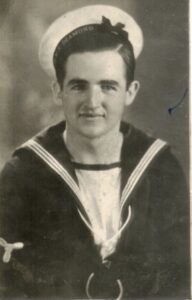
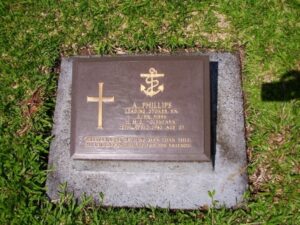
Frank David Thomas Phillips, Flight Sergeant, 1128364, Royal Air Force Volunteer Reserve. Frank was the son of John and Mary Anne Phillips of Laugharne, and the cousin of Austin Thomas Phillips. Frank joined the Royal Air Force at the outbreak of war, becoming a Flight Sergeant in 35 Squadron, RAFVR. His serial number was 1128364. He was trained as an Air Gunner-becoming a ‘Mid-Upper Gunner’. 35 Squadron was a bomber squadron, which in November 1940 was reformed for the purpose of introducing the new Handley-Page Halifax bombers into active service. The squadron was one of the groups that attempted to sink the Scharnhorst and Gneisenau during their escape dash from the North German Ports. In August 1942, 35 Squadron were incorporated into the elite ‘Pathfinder’ force, taking a major part in many bombing missions during the war, including the commando raids on Le Creusot and Peenemunde. In March 1944, the squadron converted to Lancaster’s, taking part in the D-Day bombing campaigns. On 19/20 October 1944, Frank was part of an eight-man crew of the Lancaster Mark III serial no. TL J. Their mission was to bomb the German City of Stuttgart, which was deep behind the front lines. At 17:56 on 19 October 1944, Lancaster TL J took off from RAF Gravely. The raid was numbered ND755. The Lancaster had crossed the front Lines, and was almost into Germany, when it was brought down by enemy fire. The unfortunate crew were all killed in the resulting crash and are buried together at Wintzenbach Protestant Churchyard, Bas-Rhin, France. Frank is buried in Grave 2, in the midst of his fellow crew-members. He is also commemorated on the Laugharne War Memorial.
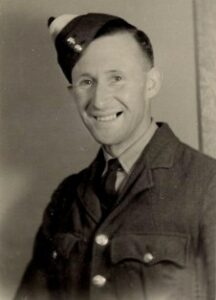
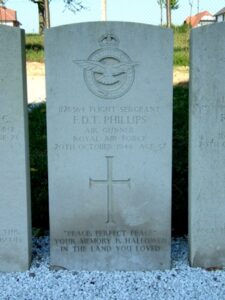
John Robert Wynford Phillips, Private, 272171, Royal Army Service Corps. John was born on 3 July 1911, the son of Richard Phillips and Hannah Phillips (nee Sharp), of Three Gates, Eglwys Cymmin. He enlisted into the army soon after the outbreak of war and served as a driver with the Royal Army Service Corps. Not much else is known of him, but he died at the Emergency Hospital, Cardiff on 22 July 1942. The remains of the 31-year-old were conveyed back home, and he was buried in Eglwyscummin Churchyard four days later.
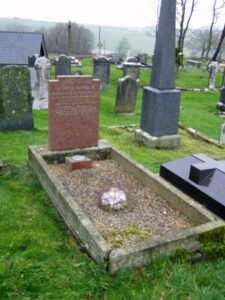
Eric Victor Seymour, Sergeant (Observer), 526601, Royal Air Force. Eric was the son of Richard William and Emily Seymour, of Pendine. He married Tressie Price in 1939. Eric enlisted into the Royal Air Force in 1936, and trained as an Observer. Eric flew with 7 Squadron, RAF, based at Oakington in Cambridgeshire. Between the wars No.7 squadron was equipped with various aircraft including the Handley Page Heyfords, Vickers Wellesleys and Armstrong Whitworth Whitleys and became the leading bomber squadron, winning the Laurence Minot Memorial Bombing Trophy more than any other squadron. At the outbreak of World War II, the squadron was equipped with Handley Page Hampdens, until August 1940, when it equipped with the RAF’s first four engined bomber, the Short Stirling Mk I – becoming the first RAF squadron to be equipped with four engined bombers. The first raid by No.7 was 10 February 1941 on Rotterdam. The squadron later settled down to a night bombing role, before becoming part of the elite Pathfinder Squadron. On the night of 23 March, 1941, the Squadron were assigned a bombing mission on Calais. Eric formed part of the crew of the Short Stirling Mk I, serial number N3643/OP, piloted by Squadron Leader Stuart Robertson. The mission was carried out successfully, but on the return journey, the Stirling caught fire. The pilot managed to get the Stirling back over the channel, and attempted a forced landing at RAF Hazelwood Common, Cambridgeshire, but the aeroplane struck power cables, before hitting the roof of a house, and crashed at 01.52, on 24 March 1941. All but one of the crew were killed in action in the crash. Squadron Leader Robertson was buried at Long Stanton Churchyard, alongside Sergeant Philip Green & Sergeant Gilbert Short. Sergeant Anthony Roberts was buried at Derby Cemetery, Sergeant John Clarke was buried in Marton Churchyard, Lancs., and Eric Victor Seymour was buried at Southend on Sea Cemetery. The lone survivor, Sergeant F. B. White was injured. Eric’s parents were informed of Eric’s tragic death by his Station Commander, who wrote; ‘He came to us with vast operational experience, and his services will be greatly missed, not only to his own Squadron, but to the RAF, which he dearly loved.’ Eric is not commemorated on the Pendine Roll of Honour.
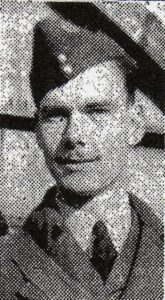
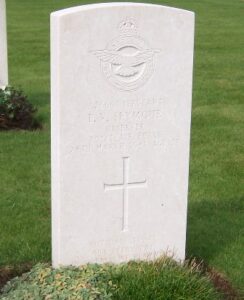
The Falklands War, 1982
Roger Nutbeem, Major, Royal Army Medical Corps. Roger was born at Bromsgrove in April 1942, the son of Frederick and Emily Nutbeem, and grew up in the town of Redditch in Worcestershire. He attended grammar school in Alcester, before starting further studies at agricultural college. In the meantime his parents moved to Pendine. After several years working in the industry, Roger decided to change his career, and in 1962 joined the RAMC as a dispenser, number 483497. In 1967 he was recommended for officer training, eventually taking on duties as a platoon officer. Roger rose through the ranks, and eventually became second in command of 16 Field Ambulance RAMC. After Argentinian troops invaded the Falkland Islands, the British sent a task force to recover the Islands. Roger was part of the RAMC deployed in early June to Ajax Bay, a settlement on East Falkland. The bay was used as a military hospital during the war and after Roger had landed there, he joined the crew on board the RFA Sir Galahad, which was travelling to Fitzroy, another settlement on the island. He was aboard the Sir Galahad when it was hit by an Argentinian Exocet missile on 8 June 1982, killing 48 men, mostly of the Welsh Guards. His body was later recovered to shore, where he was temporarily interred, and then repatriated to the UK. He now lies in the military cemetery at Tidworth in Wiltshire, in Grave E.133. In 1993 the British army opened a military hospital in the Midlands naming it in honour of Roger Nutbeem. He left a widow, and two young children.
